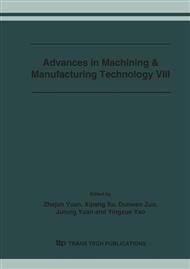p.1
p.6
p.10
p.15
p.20
p.25
p.30
p.35
p.40
The Influence of Grinding Parameters on the Superficial Hardening Effect of 48MnV Microalloyed Steel
Abstract:
The current surface strengthening process of microalloyed unquenched and tempered steel components is usually induction or laser quenching treatment. Subsequent to heat treatment, these structural parts are subjected to grinding, during which impairment of hardened materials can be caused by thermo-mechanical influence of the grinding process. This paper studies a new method of surface heat treatment by making use of grinding heat and stress to create favorable microstructures and promote high wear and fatigue resistance. This work outlines the influence of grinding parameters on the superficial hardening effect of 48MnV microalloyed steel. It was found that the thickness and hardness of the treated surface layer could be up to 1.6mm and HV750 respectively. The beneficial microstructure of the layer was created by an enhanced martensite transformation. It is highly possible that the method can be used to incorporate grinding and surface hardening into a single grinding operation to develop a cost-effective production method.
Info:
Periodical:
Pages:
15-19
Citation:
Online since:
July 2006
Authors:
Keywords:
Price:
Сopyright:
© 2006 Trans Tech Publications Ltd. All Rights Reserved
Share:
Citation:


